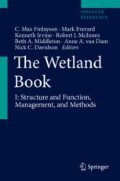Abstract
Wetlands are created or restored for a number of purposes, including flood control, water purification, sediment and nutrient retention, and biodiversity. Restoration of wetlands is the process of recreating former conditions at a site that once contained a wetland. Restoration and creation of wetlands involve the creation or restoration of hydrology, but may also include activities that alter soil composition, manipulate vegetative communities, or promote target wetland functions. Carbon accumulation in restored and created wetlands is dependent on hydrology, vascular vegetation, and microbial communities. Once hydrology is restored, consistent periods of soil inundation reduce rates of microbial decomposition by creating anoxic soils. Wetlands prior to restoration and terrestrial soils prior to development of wetland hydrology are usually carbon poor, and created wetlands often retain soil properties from the soils from which they are created, potentially taking tens of decades to build up carbon reserves similar to natural wetlands. Initial nitrogen pools reflect past land use. Agricultural sites are increasingly being converted into wetlands, resulting in many restored or created wetlands with large initial nitrogen pools due to legacy effects of fertilizer use. Since nitrogen removal via denitrification is often desirable in restored and created wetlands, increasing the duration of inundation in restored or created wetlands may be used to encourage denitrification, but microbial community biomass often is still limited by available organic carbon. Unlike carbon and nitrogen, phosphorus cycling in wetlands is primarily controlled by abiotic processes. Increasing water residence time and depth have been shown to increase soil phosphorus sorption. However, in restored or constructed wetland phosphorus release may occur in sites that initially contain elevated phosphorous levels in the soil, such as sites with agricultural legacies. Overall, the retention and recycling of carbon, nitrogen, and phosphorus are controlled by a variety of biotic and abiotic processes, themselves influenced by ambient oxygen and for restored wetlands initial nutrient concentrations that become less important over time.
References
Aldous A, McCormick P, Ferguson C, Graham S, Craft C. Hydrologic regime controls soil phosphorus fluxes in restoration and undisturbed wetlands. Restor Ecol. 2005;13:341–7.
Ann Y, Reddy KR, Delfino JJ. Influence of chemical amendments on phosphorus immobilization in soils from a constructed wetland. Ecol Eng. 1999;14:157–67.
Ardón M, Morse JL, Doyle MW, Bernhardt ES. The water quality consequences of restoring wetland hydrology to a large agricultural watershed in the southeastern coastal plain. Ecosystems. 2010;13:1060–78.
Ballantine K, Schneider R. Fifty-five years of soil development in restored freshwater depressional wetlands. Ecol Appl. 2009;19:1467–80.
Callaway JC, Sullivan G, Zedler JB. Species-rich plantings increase biomass and nitrogen accumulation in a wetland restoration experiment. Ecol Appl. 2003;13:1626–39.
Chacon N, Dezzeo N, Flores S. Effect of particle-size distribution, soil organic carbon content and organo-mineral aluminium complexes on acid phosphatases of seasonally flooded forest soils. Biol Fertil Soils. 2005;41:69–72.
Craft C. Co-development of wetland soils and benthic invertebrate communities following salt marsh creation. Wetl Ecol Manag. 2000;8:197–207.
Craft C, Broome S, Campbell C. Fifteen years of vegetation and soil development after brackish-water marsh creation. Restor Ecol. 2002;10:248–58.
Craft CB, Broome SW, Seneca ED. Nitrogen, phosphorus and organic carbon pools in natural and transplanted marsh soils. Estuaries. 1988;11:272–80.
Craft C, Megonigal P, Broome S, Stevenson J, Freese R, Cornell J, Sacco J. The pace of ecosystem development of constructed Spartina alterniflora marshes. Ecol Appl. 2003;13:1417–32.
Craft C, Reader J, Sacco JN, Broome SW. Twenty-five years of ecosystem development of constructed Spartina alterniflora (Loisel) marshes. Ecol Appl. 1999;9:1405–19.
Galatowitsch S, Budelsky R, Yetka L. Revegetation strategies for northern temperate glacial marshes and meadows. In: An international perspective on wetland rehabilitation. Dordrecht: Springer; 1999. p. 225–41.
Hansson LA, Brönmark C, Anders Nilsson P, Åbjörnsson K. Conflicting demands on wetland ecosystem services: nutrient retention, biodiversity or both? Freshw Biol. 2005;50:705–14.
Mitsch WJ, Gosselink JG. Wetlands. New York: Van Nostrand Reinhold; 1993.
Moreno-Mateos D, Power ME, Comín FA, Yockteng R. Structural and functional loss in restored wetland ecosystems. PLoS Biol. 2012;10:e1001247.
Palmer MA, Ambrose RF, Poff NL. Ecological theory and community restoration ecology. Restor Ecol. 1997;5:291–300.
Richardson CJ, Qian SS. Long-term phosphorus assimilative capacity in freshwater wetlands: a new paradigm for sustaining ecosystem structure and function. Environ Sci Technol. 1999;33:1545–51.
Serna A, Richards JH, Scinto LJ. Plant decomposition in wetlands: effects of hydrologic variation in a re-created Everglades. J Environ Qual. 2013;42:562–72.
Sutton-Grier AE, Ho M, Richardson CJ. Organic amendments improve soil conditions and denitrification in a restored riparian wetland. Wetlands. 2009;29:343–52.
Vymazal J. Removal of nutrients in various types of constructed wetlands. Sci Total Environ. 2007;380:48–65.
Zedler JB, editor. Handbook for restoring tidal wetlands. Boca Raton: CRC press; 2000.
Author information
Authors and Affiliations
Corresponding author
Editor information
Editors and Affiliations
Rights and permissions
Copyright information
© 2018 This is a U.S. Government work and not under copyright protection in the US; foreign copyright protection may apply
About this entry
Cite this entry
Langman, O., Craft, C. (2018). Carbon and Nutrient (N, P) Cycling of Created and Restored Wetlands. In: Finlayson, C.M., et al. The Wetland Book. Springer, Dordrecht. https://doi.org/10.1007/978-90-481-9659-3_328
Download citation
DOI: https://doi.org/10.1007/978-90-481-9659-3_328
Published:
Publisher Name: Springer, Dordrecht
Print ISBN: 978-90-481-3493-9
Online ISBN: 978-90-481-9659-3
eBook Packages: Biomedical and Life SciencesReference Module Biomedical and Life Sciences

